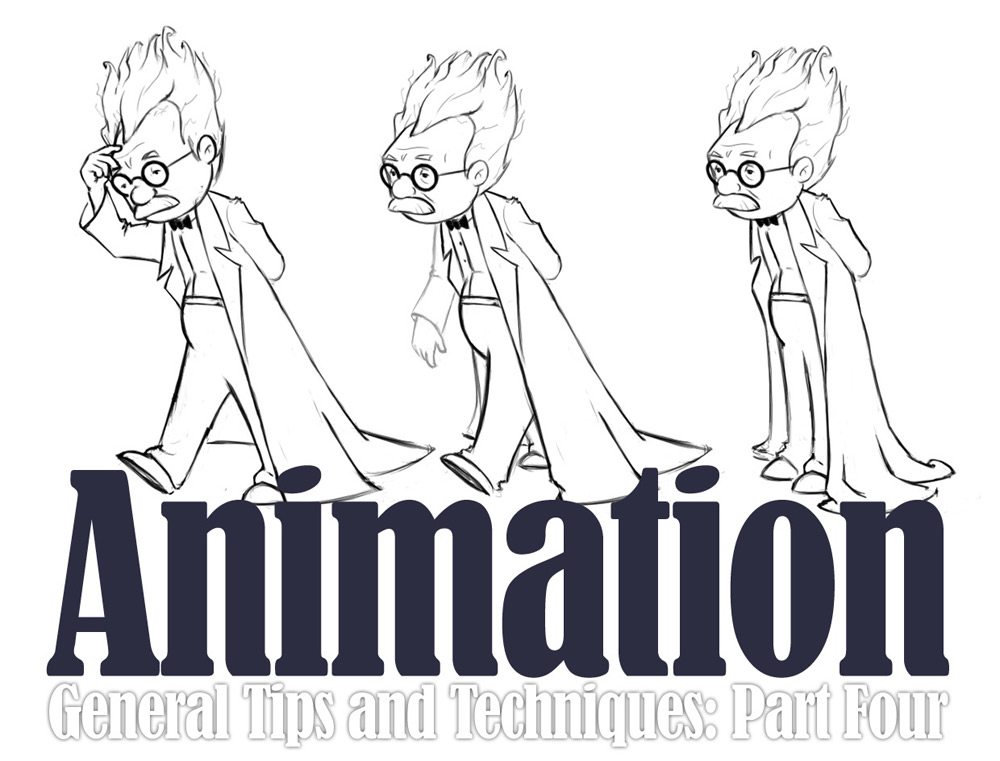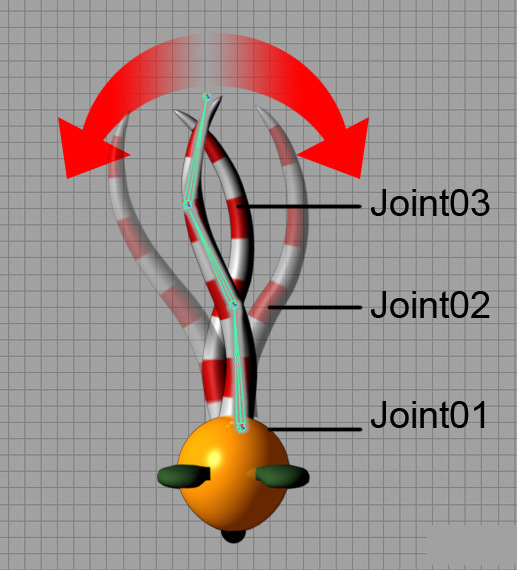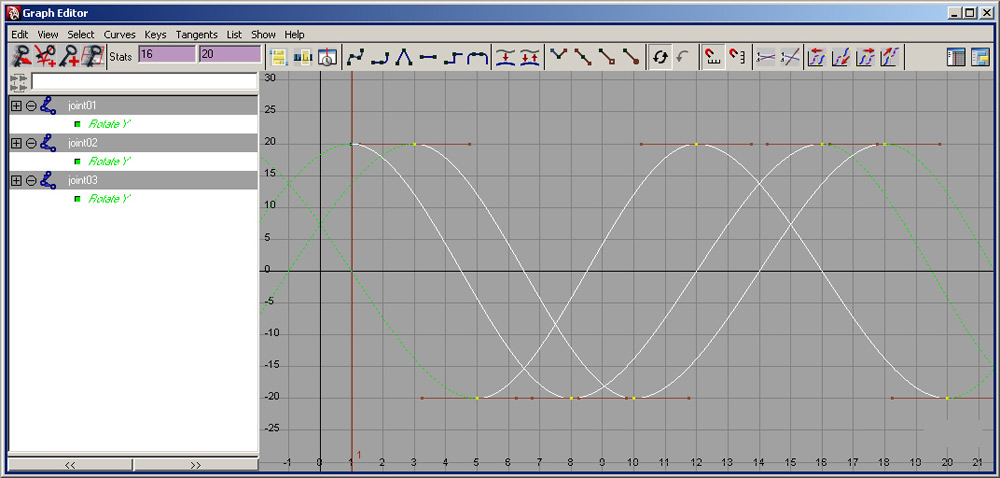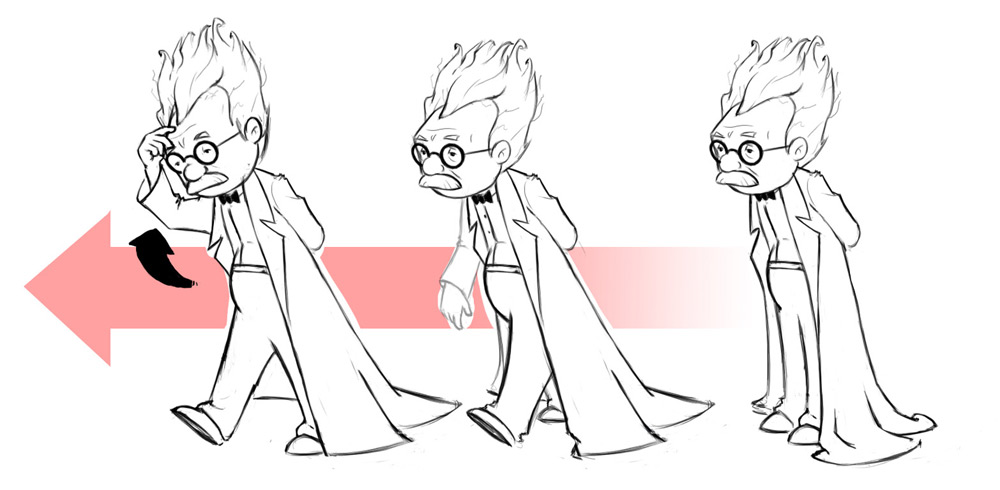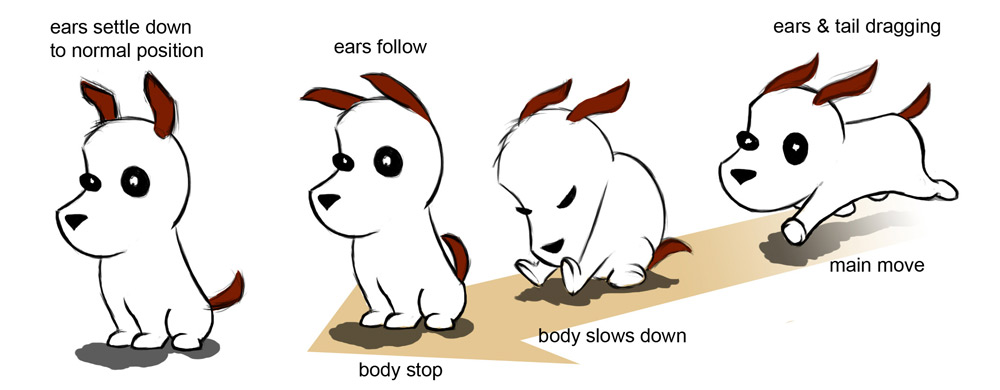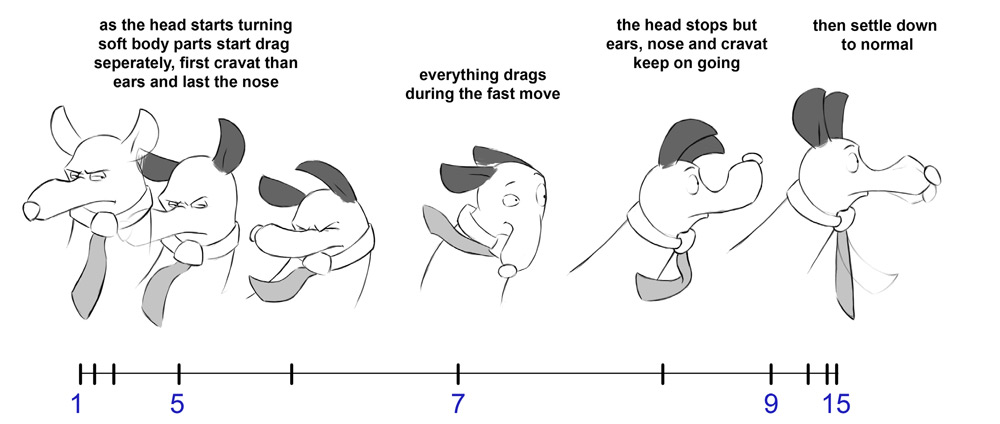Secondary Action, Overlapping Action and Follow Through
„The main method of expression, other than verbal language, is body language. Since we spend the majority of our days around other people, we are adept at reading faces and understanding body language, even though we may not really think about it.“
The most common way to animate is to blog your animation first; this is normally given to you with the animatic. With a few keyposes everyone gets the idea of what is happening in the scene. And then you can start to animate, either using the „straight ahead“ or „pose-topose“ method, or a combination of both (see previous issue!).
In order to get a feeling for your animation, you must always start with the main action and the most important movement. You want to get to the point where you think, „This is going the right way; this is what I had in mind.“ You have to be sure about the timing, weight and believability of your character and your animation! If you are satisfied with this then you can go deeper into the animation. This is the part where you have to think about secondary actions, overlapping actions and follow-throughs. And that’s what we are going to talk about here in this article!
So, what is a „secondary action“ and an „overlapping action and follow-through“…?
„Secondary Action“
In our simplified example (Fig01) you can see a ball with a tail. We are going to animate the ball falling down. The first step is to animate the main movement: letting the ball fall. Now it looks like the ball is going from one point to another, but without any sign of speed, it is uninteresting and boring. To get a feeling for the speed of the ball, we could put something in the background, like clouds or a tree, to show the movement in relation to the background. But the more interesting way for an animator to achieve this sense of movement is to animate the tail of the ball (Fig02). To support the main action and get a better feeling for the speed of the ball, we let the tail swing, as it would naturally because
of the air resistance. Depending on the tempo of the tail, you can show the ball just falling or rushing downwards. In our example, the swing of the tail is the secondary action; it helps us to understand the animation and to get a better feeling for the speed of the ball.

To get a fast result we loop the animation, so we only need three keys for every joint. If you make the loop about 16 frames long, you can make the tail move quickly. Set one extreme position at the beginning and the end; for example, rotate it to the right. It should be in the exact same position and the best way to achieve this is to copy the key. In the middle of the loop, set the other extreme position. smoothing the curves out to get a constant, fast swinging action (Fig03). Now you just need to replace the joint in the timeline (Fig04) to get a wavy tail!
Having the right idea for your animation, or strict guidelines for the scene, is necessary in order to plan your movements first. If you know what www.3dcreativemag.com page 103 Issue 036 August 2008 Animation General Tips and Techniques: Part 4 the scene is about and what the character is going to express, then you have to think about
what is the important element that will give the animation its life. A scene doesn’t just get interesting once the audience can read the emotion of the character and empathise with it, otherwise there would be no need for us to ever watch a movie!
The main method of expression, other than verbal language, is body language. Since we spend the majority of our days around other people, we are adept at reading faces and
understanding body language, even though we may not really think about it. In this way, your audience has an expert eye for understanding a specific attitude of the body or the slightest movement of a finger or an eyebrow, so unlike the viewer who absorbs every movement subconsciously, an animator has to be accurate about the animation and choose every single motion very carefully. The real challenge for an animator is getting the audience to feel what the character is feeling.
A normal running character expresses just a character running, but if you let the character look back over his shoulder with a scared expression on his face, then you’ll know that
he’s running away from something he is afraid of. These secondary actions are the most important instruments in giving your character more life and letting the audience care for him.
If you are planning your scene then you have to be sure what the main movement is, because it is superordinate to the secondary action. In Fig05 you can see a thoughtful scientist walking around and scratching his forehead. The pace – up and down – is the main movement of the body; the scratching and his meditative face are the secondary actions, and he appears to be searching for a solution in his head. You should keep in mind that the movements need to be clear and the secondary action in particular
should be readable, with an obvious silhouette and a camera position that befits it.
Overlapping Action and Follow-Through
Another very important element of any believable animation, is the „overlapping actions and follow-through“. The basic principle of this is that not everything happens at the same time. If a character is moving from one position to another and everything stops at the same time, it looks unnatural. Watch your surroundings closely and you will notice that there is always something that is dragging behind the main action. A running dog (Fig06) for example, whose ears normally hang down, will drag his ears through the air as he runs. The energy comes from the running body; if the dog suddenly stops, the energy moves to the appendages and the ears follow-through the until they settle back in the normal position.
In Fig07 you can see a rat turning his head. The main movement and the energy come from the head, and everything that is not attached closely to the body drags. But the ears, nose and scarf do not start at the same time; at the beginning of the turn the head starts moving slowly, so lighter appendages like the scarf will drag first. The ears and the nose have more weight so they will not drag until the head gets to full speed. „Overlapping action“ here means that one part starts first and then other parts follow. Again, avoid moving everything at the same time – it can be stressful for the eye! This also means that, for the overlapping action itself, the animation of the ears and the nose become more interesting and clear if they have different weights, too. The ears drag before the nose. The same principle applies for the „follow-through“ at the end of the animation. The head stops and the appendages arrive later and keep on going before they finally settle down in the normal position – first the scarf, then the ears and eventually the nose. This final example is cartoony and over-exaggerated, although it remains believable because of the different weight and compounds of the body parts.
Certainly any 3D software provides an opportunity to move those parts physically correctly – you just have to animate the main body parts and everything else will be calculated by the computer! It is a big advantage of 3D letting the computer animate things like hair, fur or clothes, and it definitely saves you a lot of time. But, if you give up too much in the physically correct properties then you will lose the chance to give your character and your animation accents and personality. With overlapping actions and follow-throughs you are able to go over the top, and for this purpose you add more weight and reality to your animation, which we surely give your character more life!
Waldemar Fast & Robert Kuczera
This tutorial was published on www.3dcreativemag.com

